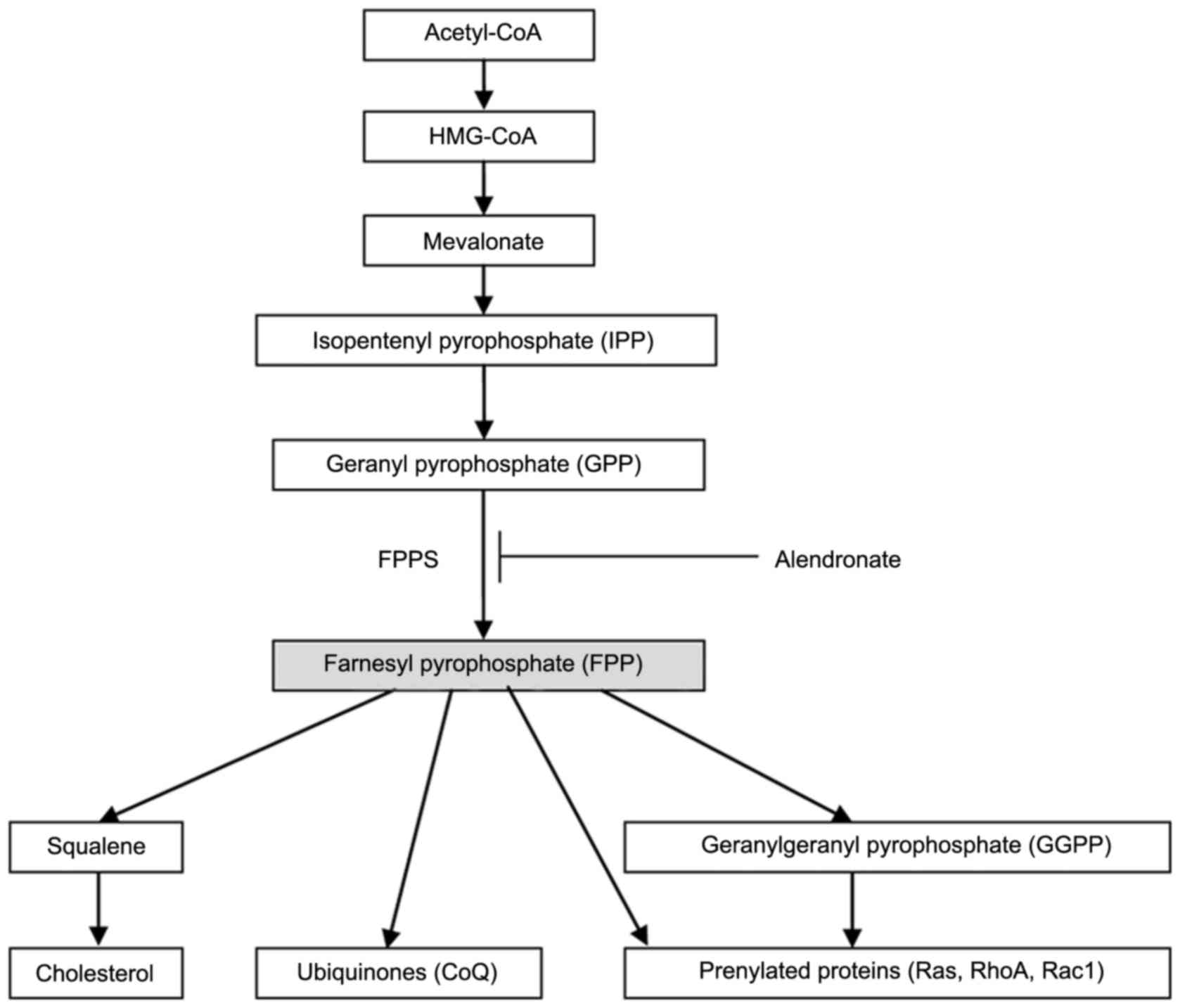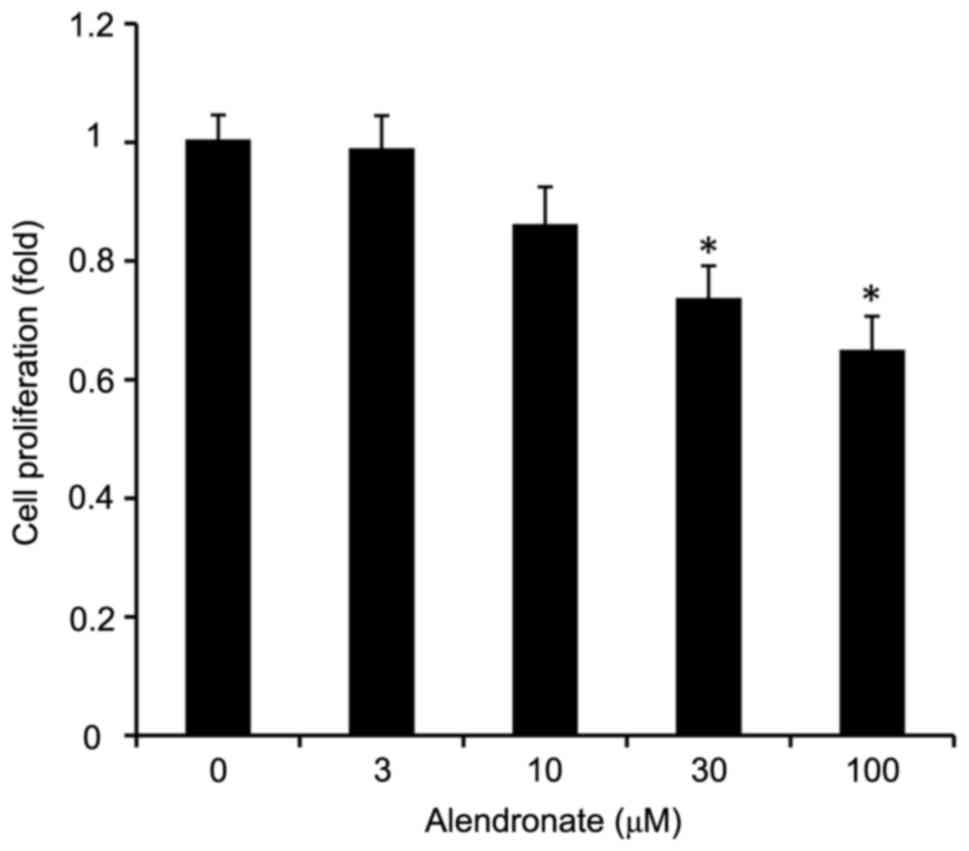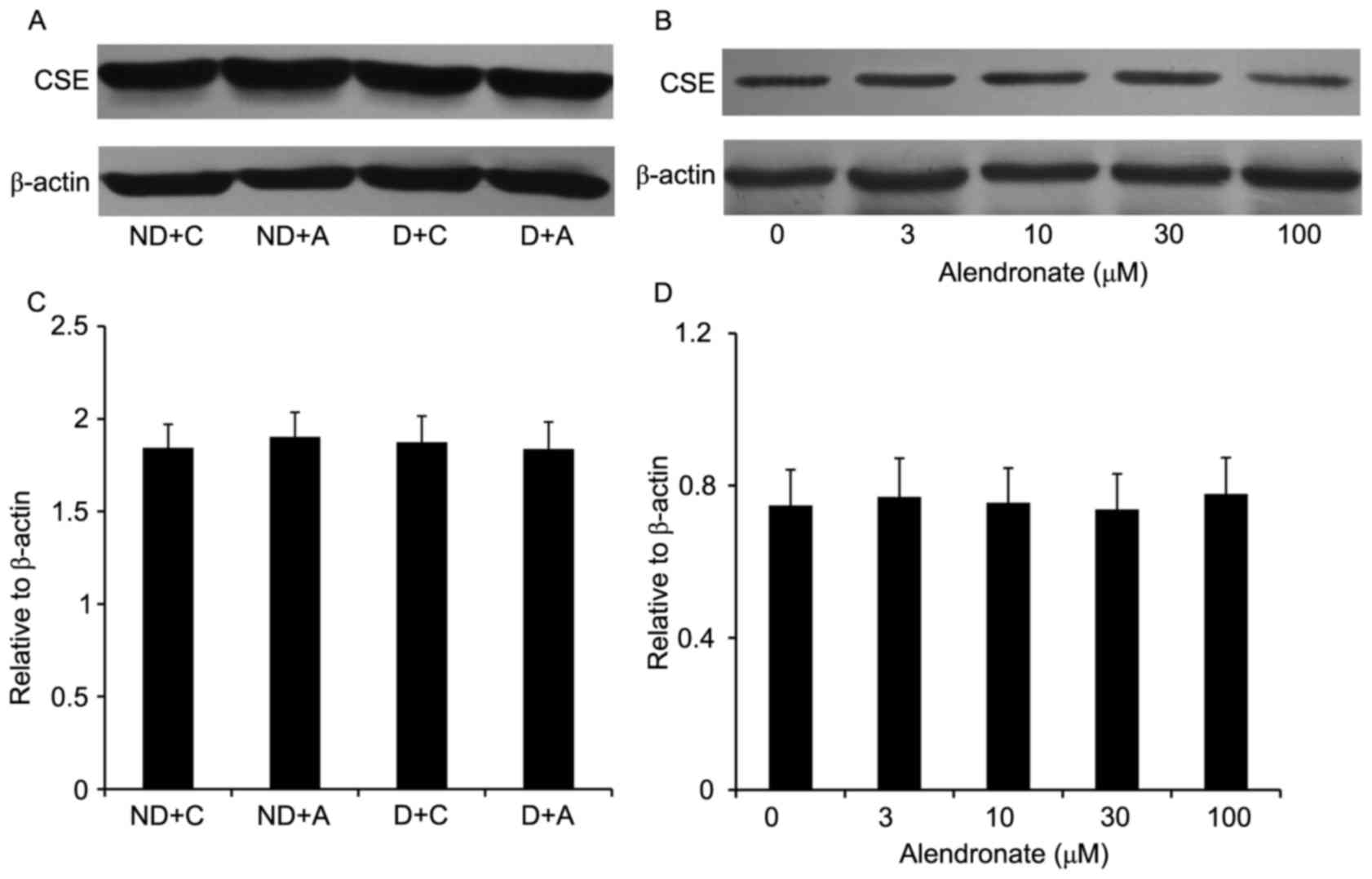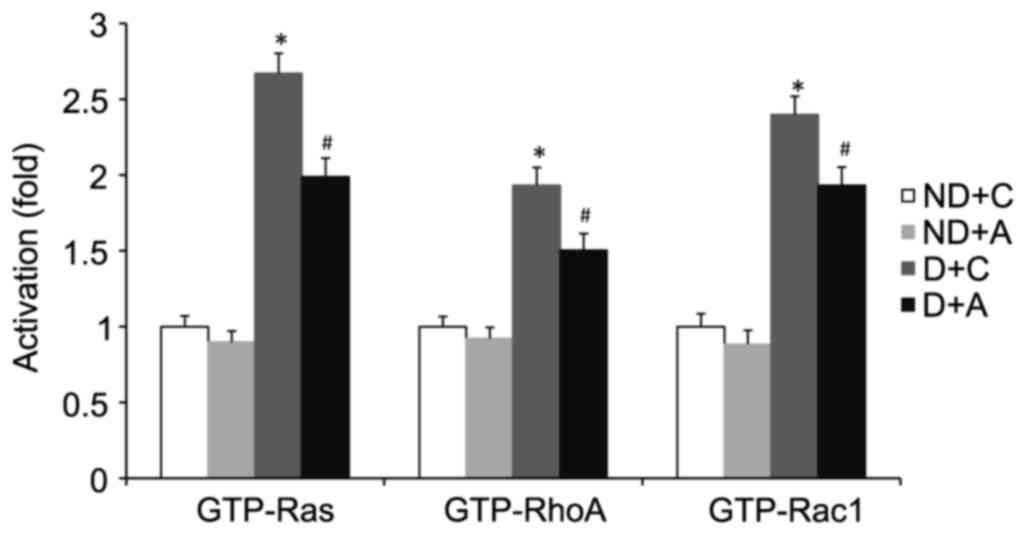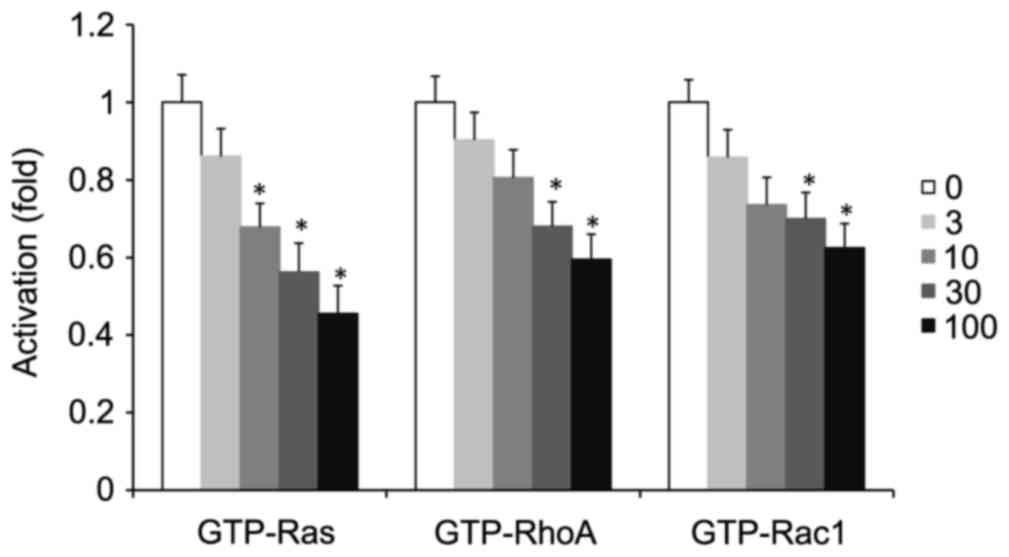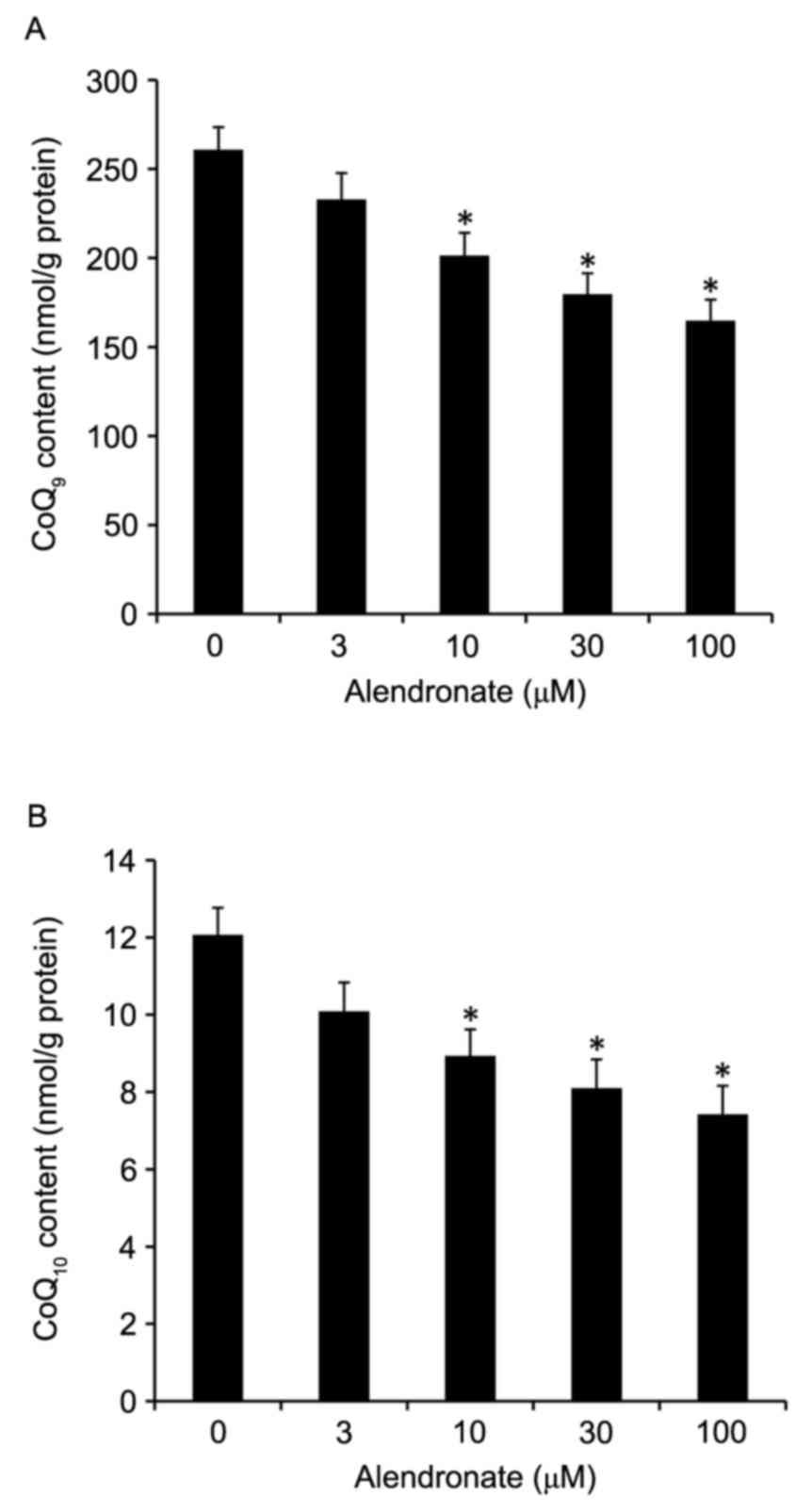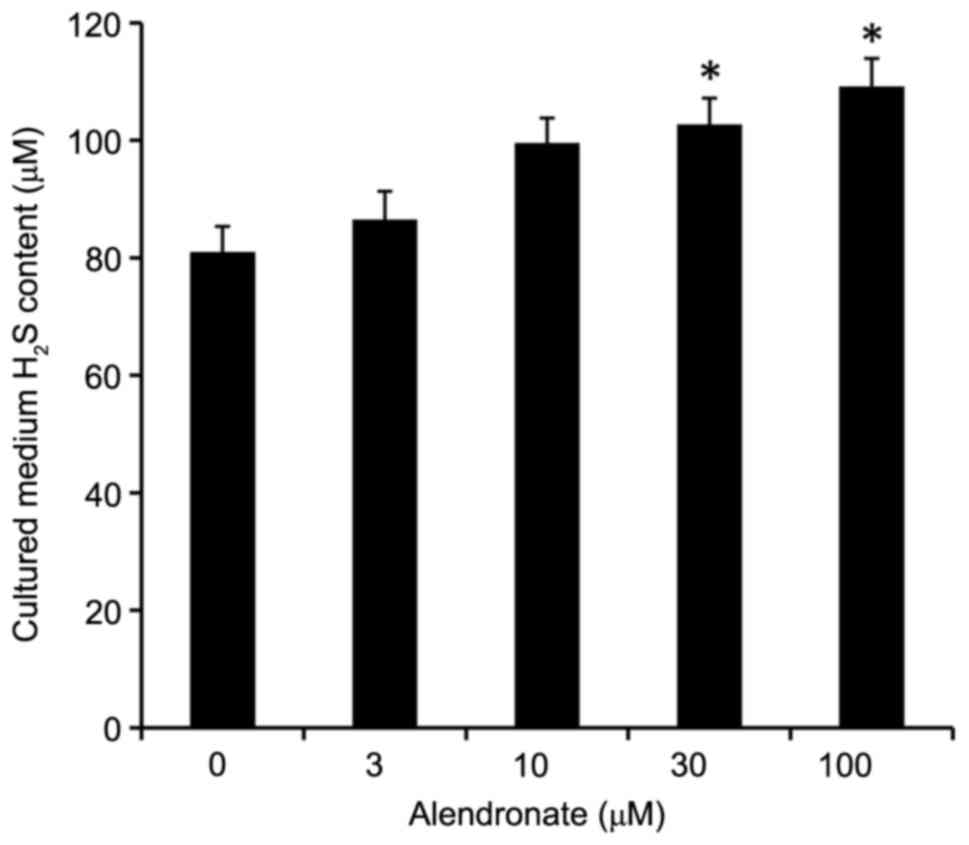Inhibition of farnesyl pyrophosphate synthase attenuates high glucose‑induced vascular smooth muscle cells proliferation
- Authors:
- Published online on: March 23, 2017 https://doi.org/10.3892/mmr.2017.6360
- Pages: 3153-3160
Abstract
Introduction
Patients with diabetes exhibit an increased susceptibility to develop a wide range of macro-vascular complications, including atherosclerotic cardiovascular and cerebrovascular disease, which account for the majority of deaths and disability in diabetes patients (1,2). Improving macro-vascular outcomes through glucose-lowering interventions have remained a difficult, complicated, and to date, largely unsuccessful enterprise. There is an ongoing need for new therapeutic targets which would slow the accelerated progression of diabetic atherosclerosis (3).
The elevated blood glucose level (hyperglycemia) is considered one of the major causes of accelerated atherosclerosis in diabetes (4,5). Together with endothelial dysfunction, the proliferation of vascular smooth muscle cells (VSMCs) is one of the characteristic features of atherosclerosis (6). Under high glucose conditions, human, porcine and rodent VSMCs proliferate and migrate from the media to the subendothelial space of the vessel wall where early atherosclerotic lesions are localized (5,6). However, the mechanisms underlying VSMCs proliferation are very complicated and have not yet been completely elucidated.
Farnesyl pyrophosphate synthase (FPPS, EC 2.5.1.10), an essential enzyme in the mevalonate pathway, catalyzes the synthesis of FPP (7). As seen in Fig. 1, FPP is a crucial branching point precursor in the synthesis of several classes of essential metabolites, including sterols (such as cholesterol), ubiquinones (also known as coenzyme Q, CoQ) and non-sterols substrates for prenylation of proteins (especially the small GTPases) (7–9). These metabolites serve as the basis for the biosynthesis of molecules used in processes as diverse as terpenoid synthesis, protein prenylation, cell membrane maintenance, hormones, protein anchoring, N-glycosylation, and steroid biosynthesis (10). In our previous studies, we found that the FPPS expression in aorta from streptozotocin (STZ)-induced diabetic mice was remarkably upregulated along with the accelerated process of atherosclerosis (11). Meanwhile, we also observed that high glucose (22.2 mM) induced both VSMCs proliferation and FPPS upregulation in vitro (11). Thus, we assumed that increased expression of aortic FPPS may contribute to the accelerated atherogenic process in diabetic mice. However, its exact relationship and mechanisms remain to be explored.
Therefore, the present study was designed to determine whether the inhibition of FPPS attenuated high glucose-induced VSMCs proliferation in vivo or in vitro, and if present, to investigate the underlying mechanisms. For this purpose, alendronate, an inhibitor of FPPS in mevalonate pathway (12,13), was used to examine the potentially critical roles of FPPS in VSMCs proliferation during the accelerated atherogenic process in diabetes mellitus.
Materials and methods
Animal treatment
Female BALB/c mice (SPF, 20±2.5 g) were purchased from the Shanghai Laboratory Animal Center (Chinese Academy of Sciences), and housed in a pathogenfree laboratory at the First Affiliated Hospital of Zhejiang University. The procedures and protocols of the study conformed to the Guide for the Care and Use of Laboratory Animal published by the US National Institutes of Health (NIH Publication no. 85-23, revised 1996) and the guidelines of the Animal Care and Use Committee of Zhejiang University. All chemicals and reagents were purchased from Sigma (S. Louis, MO, USA), unless otherwise stated. As described in our previous report (11), diabetic mice were induced by daily injection of STZ at a dose of 50 mg/kg for 5 days after a 4 h fast. Non-diabetic mice received the vehicle (citrate buffer; 0.05 M, pH 4.5). Twelve diabetic mice were randomly divided into two groups as follows: i) Diabetic mice treated with distilled water (control) group (D+C, n=6); ii) diabetic mice treated with alendronate (15 mg/kg/day) group (D+A, n=6). Twelve age and weight matched non-diabetes mice were also divided to control and alendronate group (ND+C and ND+A, n=6). Alendronate was administrated every day for 16 weeks by the intragastric route.
Glucose and lipid analysis
Fasting blood glucose (FBG) levels were evaluated in venous blood drawn from the tail by using a CONTOUR glucose meter (Bayer, Mishawaka, IN, USA). Serum total cholesterol (TC), high-density lipoprotein cholesterol (HDL-C), low-density lipoprotein cholesterol (LDL-C), and triglyceride (TG) concentrations were determined by commercial enzymatic methods (test kits from Shanghai Rongsheng Biotech, Inc., Shanghai, China).
Histological analysis
The aorta was dissected in situ from the ascending aorta to the iliac bifurcation, cleaned of peripheral fat under a dissecting microscope, and then fixed in 10% neutral formalin, embedded in paraffin, and sequentially stained with hematoxylin and eosin. Lesion areas (LA) per section were counted by taking the average of 6 sections spaced 30 µm apart, beginning at the base of the aortic root. Media thickness (MT) at 10 different points of the thoracic aorta was measured and calculated. Morphometric analysis above was performed with Image-Pro Plus 6.0.
Cell culture and treatments
VSMCs were isolated from thoracic aortic explants of female BALB/c mice as previously described (11,14). In brief, aortic explants were cultured in Dulbecco's modified Eagle's medium (DMEM; Gibco, Grand Island, NY, USA) supplemented with 10% fetal bovine serum (FBS; Gibco) and maintained at 37°C in a humidified atmosphere of 5% CO2 and 95% air. After 2 weeks, cells that had migrated onto the tissue culturedish were collected by trypsinization and subcultured successively. The identity of the VSMCs was determined by the positive immunocytochemistry reactivity to smooth muscle specific α-actin. To ensure the consistency of results, passages 5–12 of VSMCs were used for experiment. According to our previous report (11), VSMCs proliferation was induced by culturing cells in diabetic medium containing 22.2 mM glucose. Mannitol was used as an osmotic control. VSMCs were also cultured in the presence of various concentrations of alendronate (0, 3, 10, 30 and 100 µM) for 72 h.
Cell proliferation assay
After above treatments, cell proliferation was assessed by 3-[4,5-dimethylthiazol-2-yl]-2,5-diphenyltetrazolium bromide (MTT) assay as described previously (11). Cells were cultured in 96-well plates (5×103 cells/well). When the VSMCs reached a 60% confluent state, different treatments as stated above were given. Then the cells of 96 wells were incubated with 100 µl of 0.5 mg/ml MTT at 37°C for 4 h, washed with cold PBS, and lysed with 100 µl of DMSO. After the insoluble crystals were completely dissolved, the optical density of each well was immediately measured at 570 nm using an automatic microplate reader (Molecular Devices, Sunnyvale, CA, USA).
Western blot analysis
Total proteins were isolated from the aortic media (VSMCs were the only cell type in this layer) or cultured VSMCs, and the procedure of western blot analysis was performed as described in our previous reports (11,15). 10 µg protein from each sample was separated on 10% sodium dodecyl sulphate-polyacrylamide gel, electrophoresed, and transferred onto nitrocellulose membranes. The membrane was blocked with Tris-buffered saline (TBS, pH 7.6) containing 5% skim milk and 0.05% Tween-20, and then incubated with specific antibodies for 12 h at 4°C. The expressions of H2S-producing enzyme [cystathionine γ-lyase (CSE)] and total small GTPases (Ras, RhoA, and Rac1) were detected using their specific antibodies: mouse anti-CSE monoclonal antibody (1:1,000, sc-374249; Santa Cruz Biotechnology Co., Ltd., Japan), rabbit anti-Rac1 polyclonal antibody (1:1,000, sc-95; Santa Cruz Biotechnology Co., Ltd.), rabbit anti-RhoA monoclonal antibody (1:2,000, 2117; Cell Signaling Technology, Inc., Danvers, MA, USA), and rabbit anti-Ras monoclonal antibody (1:2,000, 3,339; Cell Signaling Technology, Inc.). To ensure equal protein loading, mouse monoclonal antibody to β-actin (1:5,000, ab8226; Abcam, Cambridge, UK) was used as an endogenous control. After the membrane was incubated with goat-anti-rabbit IgG conjugated to horseradish peroxidase (1:5,000 dilution; MultiSciences, Hangzhou, China) for 1 h at 37 °C, the immune complexes were visualized by the enhanced chemiluminescence (ECL) method. Quantification of the bands was carried out using densitometric analysis software Quantity One (Bio-Rad, Berkeley, CA, USA).
Small GTPases activation assay
Small GTPase (Ras, RhoA, or Rac1) activation was determined from tissue or cell lysates using Ras, RhoA, or Rac1 activation G-LISA kit (BK131, BK124, BK128; Cytoskeleton, Denver, CO, USA) according to the manufacturer's instruction. The signal was measured at 490 nm with a microplate spectrophotometer. Results are expressed as fold increase in activity compared with control group.
CoQ quantification
Concentrations of total CoQ9 and CoQ10 were determined by isocratic high-performance liquid chromatography (HPLC) according to Lang et al (16) with some modifications as follows. Cells were cultured in 12-well plates (1×105 cells/well). When the VSMCs reached a 60% confluent state, different treatments as stated above were given. Cells were resuspended and lysed in ultrapure water with addition of 1,4-benzoquinone (2 mg/ml in ethanol) to allow a complete oxidation of ubiquinol (reduced form of CoQ). The mixtures were then extracted twice by hexane/ethanol (5/2, v/v). Collected organic layers were evaporated under nitrogen, and the dried compounds were dissolved in ethanol and injected on the column Agilent TC-C18 (15 cmx0.46 cm, id 5 µm; Agilent Technologies, Inc., Palo Alto, CA, USA). All steps of sample preparation were carried out rapidly, on ice, with protection from light. The mobile phase consisted of methanol/acetonitrile/ethanol (6/2/2, v/v/v), and the isocratic elution carried out at 1 ml/min. The concentrations of compounds were detected spectrophotometrically at 275 nm using external standards CoQ11 and expressed as nmol per gram of protein (the residue mixtures were also dried under nitrogen and subjected to the protein analysis).
Measurement of Hydrogen sulfide (H2S) concentration
H2S concentrations were measured in cultured medium as described previously (17). Briefly, after different treatments, cultured medium was collected from VSMCs plate. 75 µl medium was mixed with 250 µl of 1% (w/v) zinc acetate and 425 µl distilled water in a glass test tube. Then 20 mM N, N-dimethyl-p-phenylenediamine sulfate in 7.2 mM HCl (133 µl) and 30 mM FeCl3 in 1.2 mM HCl (133 µl) were also added to the test tube for 10 min incubation at room temperature. The protein in the medium was removed by adding 250 µl of 10% trichloroacetic acid to the reaction mixture and pelleted by centrifugation at 14,000 g (5 min). The absorbance of the resulting solution at 670 nm was measured with a spectrophotometer (Molecular Devices) in a 96-well plate. All samples were assayed in duplicate, and concentration of H2S in the solution was calculated against a calibration curve of NaHS (3.125–250 µM).
Statistical analysis
All experiments were performed at least three times, and the results were expressed as mean ± standard errors of mean (SEM). All analyses were performed with SPSS (version 13.0; SPSS, Inc., Chicago, IL, USA). One-way analysis of variance (ANOVA) followed by Bonferroni post hoc test was used to determine significant differences between groups. P<0.05 was considered to indicate a statistically significant difference.
Results
Alendronate had no effect on glucose and lipid levels
As expected the STZ-induced diabetic mice had extremely higher levels of glucose than age-matched control mice. 16-week treatment with alendronate had no effect on glucose levels in neither diabetic nor non-diabetic groups (Table I). Then, in all groups, serum lipid levels (TC, LDL-C, HDL-C, and TG) were comparable (Table I).
Alendronate attenuated diabetic atherosclerosis development
The morphologic data of lesion area (LA) and media thickness (MT) were summarized in Fig. 2. In our study, STZ-induced diabetic mice developed moderate aortic atherosclerotic plaques, with a mean LA of (11.39±0.81) × 103 µm2 and MT of 91.74±6.52 µm. 16-week treatment of alendronate attenuated diabetic atherosclerosis development with a decline of LA (8.32±0.77) × 103 µm2 and MT 82.24±6.39 µm.
Alendronate inhibited the proliferation of VSMCs induced by high glucose
As an inhibitor of FPPS, alendronate dose-dependently inhibited the VSMCs proliferation induced by high glucose (Fig. 3). Alendronate at drug concentrations of 30 and 100 µM remarkably inhibited the cell proliferation in a dose-dependent manner.
Alendronate had no effect on CSE expression
16-week treatment with alendronate had no effect on aortic CSE expression of STZ-induced diabetic mice (Fig. 4). Similarly, in high glucose-treated VSMCs, alendronate (0–100 µM) didn't change the expression of CSE expression (Fig. 4).
Alendronate suppressed the activation of small GTPases
Small GTPase (Ras, RhoA, or Rac1) activation depends on its conversion from the GDP- to the GTP-bound state. The levels of the GTP-bound active form of small GTPase (Ras, RhoA, or Rac1) in aorta and cultured VSMCs were determined by G-LISA kits. The total level of small GTPase (Ras, RhoA, or Rac1) was detected by western blot using its specific antibody. 16-week treatment with alendronate had no effect on aortic expression of total Ras, RhoA, or Rac1 in four groups of mice (data not shown). However, the GTP-Ras, RhoA, and Rac1 levels were decreased in diabetic alendronate (D+A) gourp (Fig. 5). Meanwhile, the same situation occurred in high glucose-treated VSMCs in vitro. Alendronate (0–100 µM) had no effect on the expression of total Ras, RhoA, or Rac1 (data not shown). However, treatment with alendronate decreased GTP-Ras, RhoA, and Rac1 levels in a dose-dependent manner (Fig. 6).
Alendronate decreased the concentrations of total CoQ9 and CoQ10
In rodents, CoQ exists as two homologues, mainly CoQ9 with lesser amounts of CoQ10. In our study, alendronate dose-dependently decreased the total CoQ9 and CoQ10 concentrations in high glucose-treated VSMCs (Fig. 7).
Alendronate increased H2S levels
Alendronate dose-dependently increased the H2S levels in cultured medium, in which VSMCs were treated with high glucose (22.2 mM, Fig. 8).
Discussion
We herein demonstrate that inhibition of FPPS attenuates high glucose-induced VSMCs proliferation in vivo and in vitro, and the mechanisms probably involve inhibiting H2S metabolism and decreasing small GTPases activation.
It is well established that accelerated proliferation of VSMCs is the fundamental event in the development of atherosclerosis in diabetes (4–6). In our previous study, high glucose (22.2 mM) remarkably induced the VSMCs proliferation and FPPS upregulation in vitro and in vivo (11). Then, our present experiments found that treatment of alendronate attenuated the diabetic atherosclerosis process in STZ-induced mice, and that inhibition of FPPS dose-dependently attenuated high glucose-induced proliferation of VSMCs in vitro. All these findings suggested the important role of FPPS in VSMCs proliferation during diabetic accelerated atherosclerosis, but the mechanisms involved were not clear.
H2S is a member of the endogenous gasotransmitter family, in addition to nitric oxide and carbon monoxide, and plays an important role in the cardiovascular and other systems (18–20). Endogenous H2S is synthesized from L-cysteine in three different enzymatic reaction catalyzed by cystathionine β-synthase (CBS), CSE, or the sequential action of cysteine aminotransferase and 3-mercaptopyruvate sulfurtransferase (21). Among them, CSE is the pivotal H2S-producing enzyme in VSMCs, providing the main source of H2S in cardiovascular system and suppressing VSMCs proliferation in different ways (22–24). On the other hand, H2S is enzymatically scavenged or metabolized in mitochondria with the participation of CoQ (an important product of FPPS) (25,26). Thus, endogenous H2S concentration depends on its dynamic balance between synthesis and metabolism. In our study, alendronate dose-dependently increased H2S levels, but decreased total CoQ content in high glucose-treated VSMCs, without any change of CSE expression. All these data indicated that inhibition of FPPS decreased the CoQ content, depressed the H2S metabolism, increased endogenous H2S concentration, and finally attenuated the high glucose-induced proliferation of VSMCs.
On the other hand, numerous molecular and cellular studies have demonstrated that small GTPases, consisting of the Ras, RhoA and Rac1, participate in the VSMCs proliferation triggered by hyperglycemia (27–31). The membrane localization and activation of small GTPase depend on its conversion from the GDP- to the GTP-bound state via the process of protein prenylation (32–34). In our study, G-LISA method could precisely determine the level of GTP-boud active small GTPase, so as to indicate the level of protein prenylation. Alendronate, in vivo and in vitro, inhibited small GTPases (Ras, RhoA, and Rac1) activation, but had no effect on the expressions of total Ras, RhoA, and Rac1, demonstrating that FPPS inhibition only affected the activated process of small GTPases, possibly by inhibition of their prenylation. Our presumption was that inhibition of FPPS decreased isoprenoid intermediates content (FPP and GGPP, Fig. 1), depressed small GTPases (Ras, RhoA, and Rac1) activation, and finally attenuated the high glucose-induced proliferation of VSMCs.
Furthermore, alendronate, an FPPS inhibitor used in our study, is one of the bisphosphonates, using widely in bone-related disorders (35). One concern is that the half-life of bisphosphonates in the circulation is short, and they enter rapidly and extensively into bone because of their high affinity to the calcium and hydroxyapatite crystals (12). During our in vitro study, alendronate directly acted on VSMCs and exerted inhibitory effects, but whether it is still working when the drug is applied on the whole animals? Fortunately, there are supportive evidences. Bisphosphonates have also been reported to accumulate markedly in the aortas of both healthy and atherosclerotic rabbits in vivo (35) and in human internal mammary arteries in vitro (36). Thus, this leads to the hypothesis that bisphosphonates, when used in vivo, may also exert direct effects on VSMCs, which are the major cellular components of vascular wall. Indeed, our in vivo study confirmed the protective effect of FPPS inhibition on diabetic accelerated atherogenic process.
In conclusion, our study provided the experimental evidences that FPPS inhibition attenuated the high glucose-induced proliferation of VSMCs in vivo and in vitro, though depressing H2S metabolism and suppressing small GTPases (Ras, RhoA, and Rac1) activation. Although there are many essential differences between experimental and clinical studies, our finding represents a potentially promising therapeutic strategy for the treatment of diabetic macrovascular disease in the future.
Acknowledgements
This study was supported by the National Natural Science Foundation of China (no. 81500616), Natural Science Foundation of Zhejiang Province (no. LQ13H070001 and LQ16H070002), Medical Science and Technology Project of Zhejiang Province (no. 2013KYA062, 2015KYA076 and 2016KYA012), and Traditional Chinese Medicine Project of Zhejiang Province (no. 2014ZB006).
References
|
Nickerson HD and Dutta S: Diabetic complications: Current challenges and opportunities. J Cardiovasc Transl Res. 5:375–379. 2012. View Article : Google Scholar : PubMed/NCBI | |
|
Schmidt AM: Recent highlights of ATVB: Diabetes mellitus. Arterioscler Thromb Vasc Biol. 34:954–958. 2014. View Article : Google Scholar : PubMed/NCBI | |
|
Porter KE and Riches K: The vascular smooth muscle cell: A therapeutic target in type 2 diabetes? Clin Sci. 125:167–182. 2013. View Article : Google Scholar : PubMed/NCBI | |
|
Gray SP and Jandeleit-Dahm K: The pathobiology of diabetic vascular complications-cardiovascular and kidney disease. J Mol Med. 92:441–452. 2014. View Article : Google Scholar : PubMed/NCBI | |
|
Chait A and Bornfeldt KE: Diabetes and atherosclerosis: Is there a role for hyperglycemia? J Lipid Res. 50:(Suppl). S335–S339. 2009. View Article : Google Scholar : PubMed/NCBI | |
|
Rudijanto A: The role of vascular smooth muscle cells on the pathogenesis of atherosclerosis. Acta Med Indones. 39:86–93. 2007.PubMed/NCBI | |
|
Dhar MK, Koul A and Kaul S: Farnesyl pyrophosphate synthase: A key enzyme in isoprenoid biosynthetic pathway and potential molecular target for drug development. N Biotechnol. 30:114–123. 2013. View Article : Google Scholar : PubMed/NCBI | |
|
Sun S and McKenna CE: Farnesyl pyrophosphate synthase modulations: A patent review (2006–2010). Expert Opin Ther Pat. 21:1433–1451. 2011. View Article : Google Scholar : PubMed/NCBI | |
|
Goldstein JL and Brown MS: Regulation of the mevalonate pathway. Nature. 343:425–430. 1990. View Article : Google Scholar : PubMed/NCBI | |
|
Buhaescu I and Izzedine H: Mevalonate pathway: A review of clinical and therapeutical implications. Clin Biochem. 40:575–584. 2007. View Article : Google Scholar : PubMed/NCBI | |
|
Chen GP, Zhang XQ, Wu T, Li L, Han J and Du CQ: Alteration of mevalonate pathway in proliferated vascular smooth muscle from diabetic mice: Possible role in high-glucose-induced atherogenic process. J diabetes Res. 2015:3792872015. View Article : Google Scholar : PubMed/NCBI | |
|
Russell RG: Bisphosphonates: The first 40 years. Bone. 49:2–19. 2011. View Article : Google Scholar : PubMed/NCBI | |
|
Chen GP, Li L, Yang Y, Fu M, Yao L, Wu T, Zhang XQ and Hu SJ: Chronic inhibition of Farnesyl pyrophosphate synthase improves endothelial function in spontaneously hypertensive rats. Biochem Pharmacol. 80:1684–1689. 2010. View Article : Google Scholar : PubMed/NCBI | |
|
Mehrhof FB, Schmidt-Ullrich R, Dietz R and Scheidereit C: Regulation of vascular smooth muscle cell proliferation: Role of NF-kappaB revisted. Circ Res. 96:958–964. 2005. View Article : Google Scholar : PubMed/NCBI | |
|
Chen GP, Yao L, Lu X, Li L and Hu SJ: Tissue-specific effects of atorvastatin on 3-hydroxy-3-methylglutarylcoenzyme A reductase expression and activity in spontaneously hypertensive rats. Acta Pharmacol Sin. 29:1181–1186. 2008. View Article : Google Scholar : PubMed/NCBI | |
|
Lang JK, Gohil K and Packer L: Simultaneous determination of tocopherols, ubiquinols, and ubiquinones in blood, plasma, tissue homogenates, and subcellular fractions. Anal Biochem. 157:106–116. 1986. View Article : Google Scholar : PubMed/NCBI | |
|
Zhu YZ, Wang ZJ, Ho P, Loke YY, Zhu YC, Huang SH, Tan CS, Whiteman M, Lu J and Moore PK: Hydrogen sulfide and its possible roles in myocardial ischemia in experimental rats. J Appl Physiol (1985). 102:261–268. 2007. View Article : Google Scholar : PubMed/NCBI | |
|
Xu S, Liu Z and Liu P: Targeting hydrogen sulfide as a promising therapeutic strategy for atherosclerosis. Int J Cardiol. 172:313–317. 2014. View Article : Google Scholar : PubMed/NCBI | |
|
Vandiver M and Snyder SH: Hydrogen sulfide: A gasotransmitter of clinical relevance. J Mol Med (Berl). 90:255–263. 2012. View Article : Google Scholar : PubMed/NCBI | |
|
Gadalla MM and Synder SH: Hydrogen sulfide as a gasotransmitter. J Neurochem. 113:14–26. 2010. View Article : Google Scholar : PubMed/NCBI | |
|
Whiteman M, Le Trionnaire S, Chopra M, Fox B and Whatmore J: Emerging role of hydrogen sulfide in health and disease: Critical appraisal of biomarkers and pharmacological tools. Clin Sci. 121:459–488. 2011. View Article : Google Scholar : PubMed/NCBI | |
|
Mani S, Untereiner A, Wu L and Wang R: Hydrogen sulfide and the pathogenesis of atherosclerosis. Antioxid Redox Signal. 20:805–817. 2014. View Article : Google Scholar : PubMed/NCBI | |
|
Qiao W, Chaoshu T, Hongfang J and Junbao D: Endogenous hydrogen sulfide is involved in the pathogenesis of atherosclerosis. Biochem Biophys Res Commun. 396:182–186. 2010. View Article : Google Scholar : PubMed/NCBI | |
|
Elsey DJ, Fowkes RC and Baxter GF: Regulation of cardiovascular cell function by hydrogen sulfide (H(2)S). Cell Biochem Funct. 28:95–106. 2010. View Article : Google Scholar : PubMed/NCBI | |
|
Martelli A, Testai L, Marino A, Breschi MC, Da Settimo F and Calderone V: Hydrogen sulphide: Biopharmacological roles in the cardiovascular system and pharmaceutical perspectives. Curr Med Chem. 19:3325–3326. 2012. View Article : Google Scholar : PubMed/NCBI | |
|
Beltowski J and Jamroz-Wisniewska A: Modulation of H(2)S metabolism by statins: A new aspect of cardiovascular pharmacology. Antioxid Redox Signal. 17:81–94. 2012. View Article : Google Scholar : PubMed/NCBI | |
|
Chen J, Dai M and Wang Y: Paeonol inhibits proliferation of vascular smooth muscle cells stimulated by high glucose via Ras-Raf-ERK1/2 signaling pathway in coculture model. Evid Based Complement Alternat Med. 2014:4842692014. View Article : Google Scholar : PubMed/NCBI | |
|
Zhao Y, Liu J, Li L, Liu L and Wu L: Role of Ras/PKCzeta/MEK/ERK1/2 signaling pathway in angiotensin II-induced vascular smooth muscle cell proliferation. Regul Pept. 128:43–50. 2005. View Article : Google Scholar : PubMed/NCBI | |
|
Ishiko K, Sakoda T, Akagami T, Naka T, Doi T, Tsujino T, Masuyama T and Ohyanagi M: Hyperglycemia induced cell growth and gene expression via the serum response element through RhoA and Rho-kinase in vascular smooth muscle cells. Prep Biochem Biotechnol. 40:139–151. 2010. View Article : Google Scholar : PubMed/NCBI | |
|
Sawada N, Li Y and Liao JK: Novel aspects of the roles of Rac1 GTPase in the cardiovascular system. Curr Opin Pharmacol. 10:116–121. 2010. View Article : Google Scholar : PubMed/NCBI | |
|
Zhu LH, Wang L, Wang D, Jiang H, Tang QZ, Yan L, Bian ZY, Wang XA and Li H: Puerarin attenuates high-glucose and diabetes-induced vascular smooth muscle cell proliferation by blocking PKCbeta2/Rac1-dependent signaling. Free Radic Biol Med. 48:471–482. 2010. View Article : Google Scholar : PubMed/NCBI | |
|
McTaggart SJ: Isoprenylated proteins. Cell Mol Life Sci. 63:255–267. 2006. View Article : Google Scholar : PubMed/NCBI | |
|
Roskoski R Jr: Protein prenylation: A pivotal posttranslational process. Biochem Biophys Res Commun. 303:1–7. 2003. View Article : Google Scholar : PubMed/NCBI | |
|
Casey PJ: Protein lipidation in cell signaling. Science. 268:221–225. 1995. View Article : Google Scholar : PubMed/NCBI | |
|
Ylitalo R, Mönkkönen J, Urtti A and Ylitalo P: Accumulation of bisphosphonates in the aorta and some other tissues of healthy and atherosclerotic rabbits. J Lab Clin Med. 127:200–206. 1996. View Article : Google Scholar : PubMed/NCBI | |
|
Ylitalo R, Kalliovalkama J, Wu X, Kankaanranta H, Salenius JP, Sisto T, Lähteenmäki T, Ylitalo P and Pörsti I: Accumulation of bisphosphonates in human artery and their effects on human and rat arterial function in vitro. Pharmacol Toxicol. 83:125–131. 1998. View Article : Google Scholar : PubMed/NCBI |



